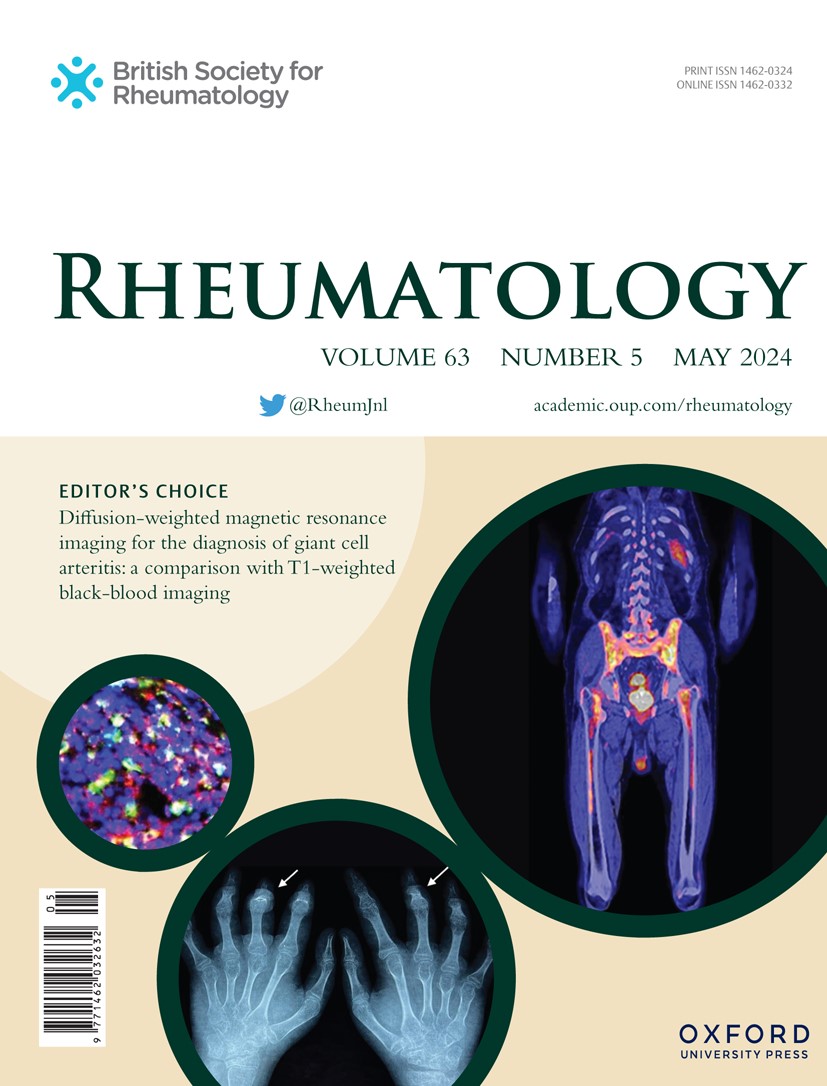Disease activity and mental health symptoms in axial spondyloarthritis: concordant or discordant?
IF 4.4
2区 医学
Q1 RHEUMATOLOGY
引用次数: 0
Abstract
OBJECTIVE We applied latent class and trajectory modelling to examine whether subgroups of axial spondylarthritis (axSpA) patients report discordant scores for disease activity and mental health symptoms at baseline and after treatment change. METHODS We analysed axSpA patients from the ASAS Health Index International Validation Study. We applied latent class analysis (LCA) using generalized structural equation modelling to identify subgroups among 1292 individuals, based on baseline Hospital Anxiety and Depression Scale (HADS) subscores and ASDAS. We applied trajectory modelling in a subset (n = 206) requiring treatment change, to identify subgroups of distinct trajectories for HADS and ASDAS over 6 months. All indices were standardised. Baseline characteristics were compared across identified groups. RESULTS For the baseline analysis, three groups were identified with concordant HADS subscores and ASDAS, with similar baseline characteristics except the high HADS/ASDAS group having more peripheral joint involvement and higher CRP levels. Trajectory analysis identified four groups with concordant HADS and ASDAS changes: 54% comparatively low baseline values, 33% medium and, of the high baseline groups, some (7%) had marked improvement (HADS-depression Δ11, HADS-anxiety Δ9, ASDAS Δ2.8), while others (6%) had limited ASDAS improvement (Δ1.4) with minimal changes in anxiety symptoms (Δ0.6). CONCLUSIONS We did not identify the hypothesized subgroups with discordant disease activity and mental health symptoms. Instead, these domains were closely aligned at baseline and following treatment, suggesting that these symptoms influence each other. Patients with high mental health symptom burden may benefit from knowing that these symptoms often improve alongside disease activity when starting treatment.轴型脊柱炎的疾病活动性与心理健康症状:一致还是不一致?
目的:我们应用潜在类别和轨迹模型来检查轴型脊柱炎(axSpA)患者亚组在基线和治疗改变后的疾病活动性和心理健康症状评分是否不一致。方法对来自ASAS健康指数国际验证研究的axSpA患者进行分析。基于医院焦虑和抑郁量表(HADS)的基线分和ASDAS,我们应用潜在类分析(LCA),利用广义结构方程模型在1292名个体中确定亚群。我们在需要改变治疗的子集(n = 206)中应用轨迹建模,以确定HADS和ASDAS在6个月内不同轨迹的亚组。所有指标均已标准化。在确定的组间比较基线特征。结果在基线分析中,除了HADS/ASDAS高组有更多外周关节受累和更高CRP水平外,三组的HADS亚评分和ASDAS一致,基线特征相似。轨迹分析确定了四组具有一致的HADS和ASDAS变化:54%的基线值相对较低,33%的基线值中等,在高基线组中,一些(7%)有明显的改善(HADS-抑郁Δ11, HADS-焦虑Δ9, ASDAS Δ2.8),而其他(6%)的ASDAS改善有限(Δ1.4),焦虑症状变化很小(Δ0.6)。结论:我们没有确定疾病活动和心理健康症状不一致的假设亚组。相反,这些区域在基线和治疗后紧密排列,表明这些症状相互影响。有高精神健康症状负担的患者如果知道这些症状通常在开始治疗时随着疾病活动而改善,可能会受益。
本文章由计算机程序翻译,如有差异,请以英文原文为准。
求助全文
约1分钟内获得全文
求助全文
来源期刊

Rheumatology
医学-风湿病学
CiteScore
9.40
自引率
7.30%
发文量
1091
审稿时长
2 months
期刊介绍:
Rheumatology strives to support research and discovery by publishing the highest quality original scientific papers with a focus on basic, clinical and translational research. The journal’s subject areas cover a wide range of paediatric and adult rheumatological conditions from an international perspective. It is an official journal of the British Society for Rheumatology, published by Oxford University Press.
Rheumatology publishes original articles, reviews, editorials, guidelines, concise reports, meta-analyses, original case reports, clinical vignettes, letters and matters arising from published material. The journal takes pride in serving the global rheumatology community, with a focus on high societal impact in the form of podcasts, videos and extended social media presence, and utilizing metrics such as Altmetric. Keep up to date by following the journal on Twitter @RheumJnl.
 求助内容:
求助内容: 应助结果提醒方式:
应助结果提醒方式:


